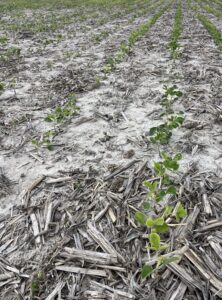Illinois Crop Update – May 30, 2025
Kathryn Seebruck – Commercial Agriculture Educator
Stephenson County
Soil Conditions: Mildly Wet (soil is wetter than normal, local vegetation is healthy)
Across the county, corn is between VE and about V4 while soybeans are yet to emerge or at about V1. The rainfall received over the past couple weeks has been well received – the crop looks healthy and green. Surprisingly given the rain, there aren’t yet any significant weed flushes, but scouting is recommended to identify any moving forward.
Steve Brand – Commercial Agriculture Specialist
DeKalb County
Soil Conditions: Mildly Dry (soil is drier than normal, plant growth may have slowed)
The recent rains have brought some much-needed relief for crops in the early growing season. Northern IL in general still remains in a D1 drought stemming from the dry winter and dry spring. The Dekalb area has received 1.5-2 inches of rain in the past week which has pushed the remaining fields in the region to emergence. May overall has brought under 5 inches of rain to date.
Corn has emerged in most if not all fields. The crop is ranging from VE to pushing V4. The early drought at planting along with cooler temperatures since emergence has stunted the corn slightly, but the crop has great vigor and is showing no signs of major drought stress currently. There are very few wet spots in fields and little to no disease or root rots in fields.
Soybeans are still emerging and pushing through in some of the no-till fields. Fields that have emerged are ranging from VE to V2 with second trifoliates unfolding. Beans overall look healthy with uniform emergence and are showing no signs of drought or disease.
Wheat is at full head and growth stage Feekes 10.5.3, or full anthesis. The dry conditions have kept disease down overall and fields are looking clean. With the recent rain disease monitoring will continue as we scout for head scab and various seed blights.


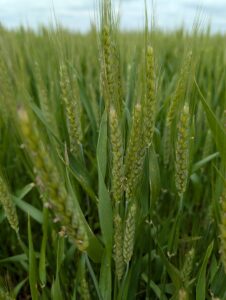
Russ Higgins – Commercial Agriculture Educator
Grundy County
Soil Conditions: Near Normal
Below average temperatures this week have slowed crop growth. Most planting is complete and limited replant, mostly soy, has taken place. While most observations are focused on aboveground 2025 crop development, it is interesting to consider what is happening underground. While variation exists among hybrids and locations we can share several generalizations about corn root growth. The maximum rooting depth is largely determined by the depth of the groundwater table. Corn roots require oxygen to respire and survive, for this reason most corn root growth ceases once the water table (and saturated soil) is reached. Roots can be expected to extend or “meet” across 30-inch rows by the corn plant at V6 but has been reported in earlier stages in favorable growing conditions. The corn plants’ maximum root depth, which can reach six feet (if not limited by soil barriers) is normally attained by the blister or milk stage in the growing season. Maximum root depth can be helpful, but we are reminded that most of the root density is in the top two to three feet of the soil profile.
While scouting fields this week I am visually reminded of management suggestions shared by Extension Weed Specialists, including Dr. Aaron Hager, on the importance of preventing Waterhemp from reaching the stage of viable seed production. When allowed to do so, these prolific seed producing weeds can generate an impressive flush of weed seedlings the following year. Despite the cool week, burcucumber is getting an early start and has been noted as well. Evaluate stand and post herbicide efficacy in both corn and soy fields in the upcoming weeks.
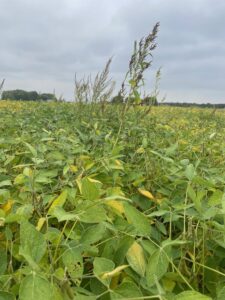
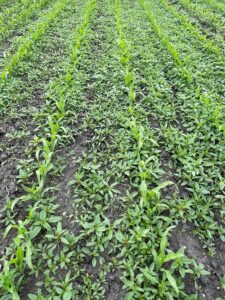
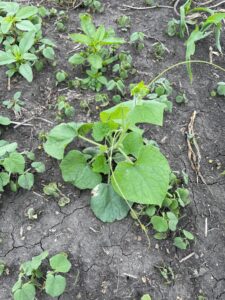
Reagan Tibbs – Commercial Agriculture Educator
Logan County
Soil Conditions: Moderately Wet (soil is damp, standing water may be present in low areas, water bodies are full)
Conditions have remained favorable for crop growth across Logan County over the last week. Nearly all of the fields across the county have been planted and emerged. Some of the earlier-planted corn has reached V3 or V4 stages, with most corn still in the V1-V2 stage. For soybeans, the earlier-planted fields are in the V2 stage, while most others are in the VC-V1 stage.
Doug Gucker – Local Food Systems and Small Farms Educator
Dewitt, Macon, and Piatt County
Soil Conditions: Mildly Wet (soil is wetter than normal, local vegetation is healthy)
The crop conditions across my 3-county area vary from just planted corn to V4 stage corn. The soybean fields are much the same with newly planted to almost V3 (3rd trifoliate). Sidedressing of corn and post emergent weed control are in progress. Crops look good except for fields that have experienced severe weather damage.

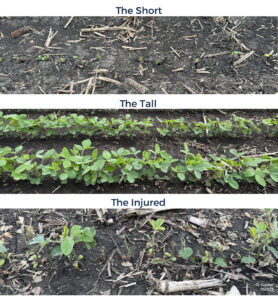
Talon Becker – Commercial Agriculture Specialist
Douglas County
Soil Conditions: Near Normal
All but maybe a handful of corn and soy fields have been planted in Douglas County. For both corn and soy, most fields are still in earlier stages of development (V1-V2), and I also saw several fields that were just now emerging (VE). However, there were a number of fields in certain pockets of the county reaching V3-V4 for soy and V4-V5 for corn. The few wheat fields I saw were on the tail end of flowering (Feekes 10.5.4).
Weed pressure appeared to still be low in most corn fields, but I found a few soybean fields that will be needing a post-emergence application before too long. With warmer weather and not too much rain in the forecast next week, soils should be dry enough to handle traffic in most fields. The warmer weather also means emerged weeds, particularly waterhemp, will grow quickly, thereby reducing the efficacy of chemical control options. Because of this and varying degrees of herbicide resistance in waterhemp populations, it is recommended to apply post-emergence herbicides when waterhemp is no more than 3-4 inches in height. For more information on waterhemp biology and control options, check out the resources linked below from the Getting Rid Of Weeds (GROW) website.
https://growiwm.org/weeds/waterhemp/
https://growiwm.org/wp-content/uploads/2024/09/20200921-factsheet-waterhemp-ada-usdadraft.pdf

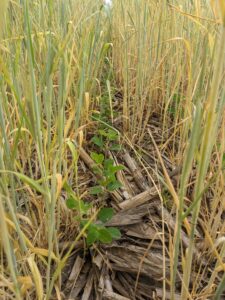
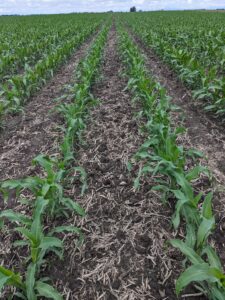
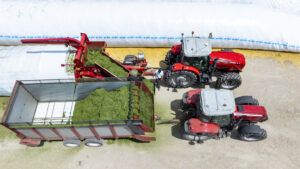
Dane Hunter – Commercial Agricultural Specialist
Marion County
Soil Conditions: Mildly Wet (soil is wetter than normal, local vegetation is healthy)
A considerable amount of planting has taken place over the last two weeks. A decent number of cornfields are spiking around the county. I’ve also spotted a couple of soybean fields around V2. The photo I’m adding is one of those fields, where the stand was a little spotty and it had already been replanted, with the interseeded beans just cracking the surface. The last major storm predicted over Memorial Day weekend fizzled out, which helped planting considerably.
Wheat is starting to senesce in areas damaged by standing water. While the bulk of the field is still green, it’s clear we are just a few weeks out from maturity
